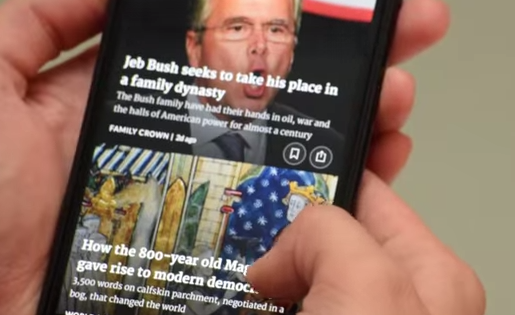This week we explore a publishing platform that integrates story components in a unique way, and a startup that organizes news reports around historical context.
PART 1: FOLD
A Web-based publishing platform developed at the MIT Media Lab arranges related elements in a visual way that puts multimedia material into view alongside the text. Co-creator Alexis Hope tells us how the two-dimensional structure is enabling some experiments with storytelling.
Reporting by Daniel Shapiro.
[To skip directly to this segment in YouTube, click here.]
Additional information:
FOLD puts referenced material into view, “capturing some of your attention in your peripheral vision as you read the core, trunk text,” writes Ethan Zuckerman, who taught the course at MIT in which a student team created the initial version of FOLD. “I find that when I write on the platform, I’m far more likely to include rich imagery and video, which makes my stories visualizable and understandable in a very different way than blog posts.”
Open-source code that powers FOLD is available in a GitHub repository.
Examples:
- “What You Need to Know about the Cuban Thaw” — Integrates looping video clips, map imagery and other visuals to illuminate an explanation of the change in U.S. policy toward Cuba.
- “The Mark Jensen Case” — Presents a historical overview of a complicated murder case by supplementing blocks of text with photos, quotes and links to additional material.
- “Getting gritty with it” — Uses text, video, images and links to explain the concept of “grit,” i.e. showing resolve to overcome obstacles and conquer procrastination.
- “A Culinary Vacation” — Demonstrates how supplementary material could accompany a recipe.
- “How I Found Jewish Renewal, And Why I Stayed” — Adds contextual background elements to a personal essay.
PART 2: Timeline
Timeline is a technology-driven news operation that infuses historical context into the news of the day. We learn from Editor-in-Chief Jonathan Kalan how the team delivers stories in a time-based format optimized for mobile devices.
Reporting by Daniel Shapiro.
[To skip directly to this segment in YouTube, click here.]
In addition to the responsive website, Timeline is available via a native iOS app.
Reuben Stern is the deputy director of the Futures Lab at the Reynolds Journalism Institute and host and co-producer of the weekly Futures Lab video update.
 The Reynolds Journalism Institute’s Futures Lab video update features a roundup of fresh ideas, techniques and developments to help spark innovation and change in newsrooms across all media platforms. Visit the RJI website for the full archive of Futures Lab videos, or download the iPad appto watch the show wherever you go. You can also sign up to receive email notification of each new episode.
The Reynolds Journalism Institute’s Futures Lab video update features a roundup of fresh ideas, techniques and developments to help spark innovation and change in newsrooms across all media platforms. Visit the RJI website for the full archive of Futures Lab videos, or download the iPad appto watch the show wherever you go. You can also sign up to receive email notification of each new episode.

